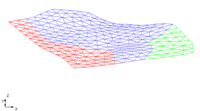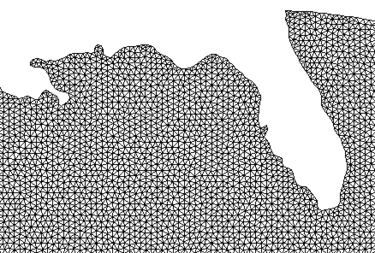GMS:2D Mesh Polygon Attributes: Difference between revisions
From XMS Wiki
Jump to navigationJump to search
| Line 12: | Line 12: | ||
:Adaptive tessellation is a mesh generation technique used to fill the interior of a polygon. A polygon is assigned to be adaptive tessellation in the ''Polygon Attributes'' dialog and is filled with the '''Map → 2D Mesh''' command. | :Adaptive tessellation is a mesh generation technique used to fill the interior of a polygon. A polygon is assigned to be adaptive tessellation in the ''Polygon Attributes'' dialog and is filled with the '''Map → 2D Mesh''' command. | ||
:[[Image:adapt. | :[[Image:adapt.png|thumb|left|375 px|Example mesh created using adaptive tessellation]] | ||
:Adaptive tessellation uses the existing spacing on the polygons to determine the element sizes on the interior. Any interior arcs and refine points are forced into the new mesh. If the input polygon has varying node densities along its perimeter, GMS attempts to create a smooth element size transition between these areas of differing densities. By altering the size bias, the user can indicate whether GMS should favor the creation of large or small elements. Decreasing the bias will result in smaller elements; increasing the bias will result in larger elements. In either case, the elements in the interior of the mesh will honor the arc edges and the element sizes specified at nodes. The bias simply controls the element sizes in the transition region. | :Adaptive tessellation uses the existing spacing on the polygons to determine the element sizes on the interior. Any interior arcs and refine points are forced into the new mesh. If the input polygon has varying node densities along its perimeter, GMS attempts to create a smooth element size transition between these areas of differing densities. By altering the size bias, the user can indicate whether GMS should favor the creation of large or small elements. Decreasing the bias will result in smaller elements; increasing the bias will result in larger elements. In either case, the elements in the interior of the mesh will honor the arc edges and the element sizes specified at nodes. The bias simply controls the element sizes in the transition region. | ||

